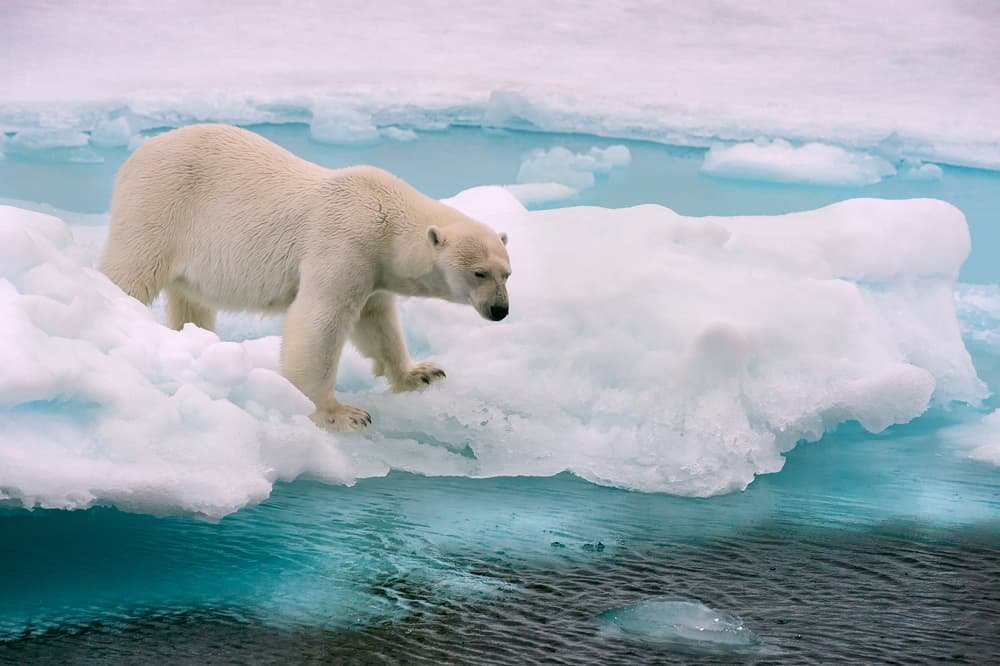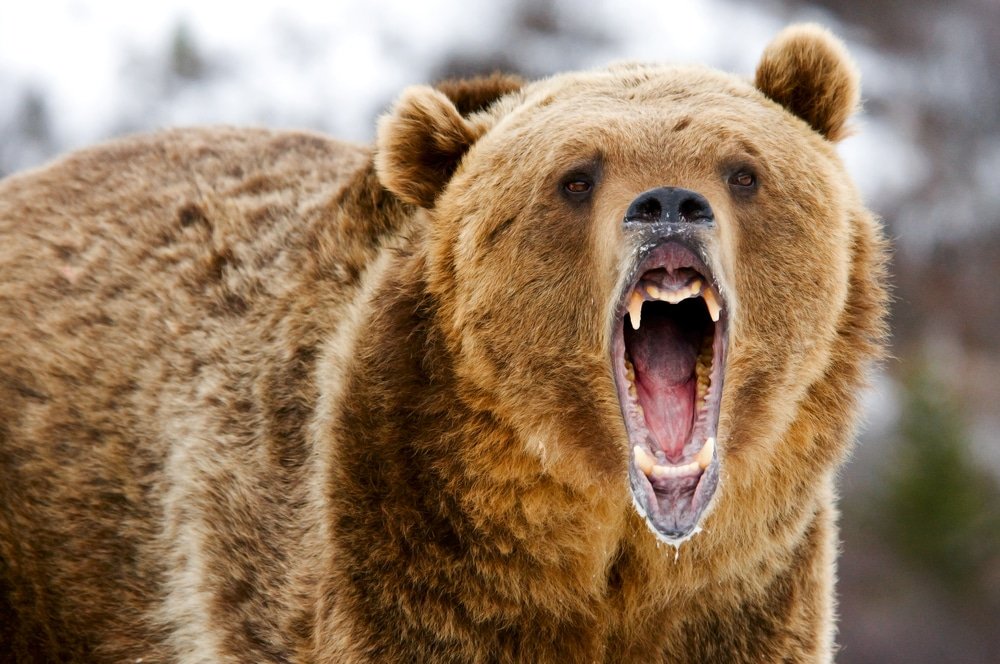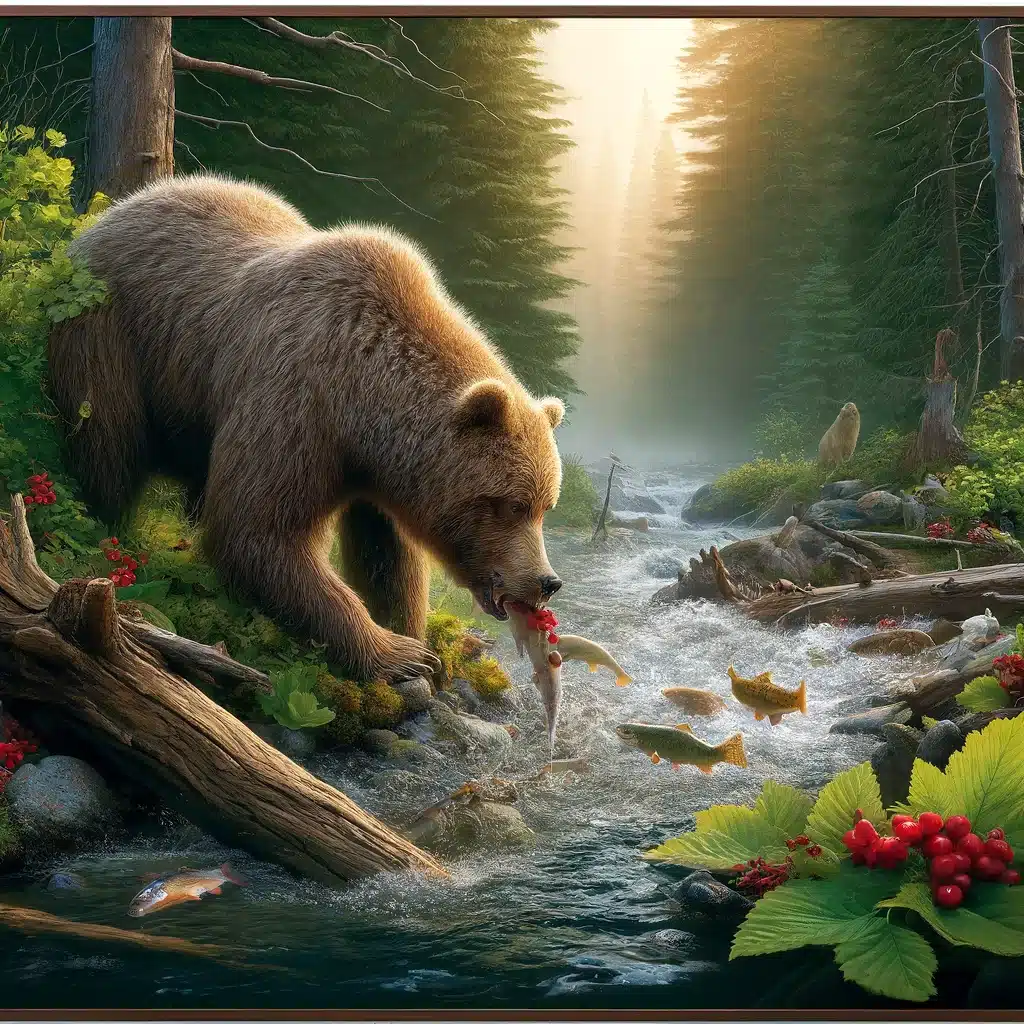Have you ever wondered who would win in a fight: a giant, white, fur-covered refrigerator or a hulking brown mountain of a bear? While I don’t recommend an actual brawl, the polar bear vs grizzly bear is an undeniably powerful predator combination of bear species.
But when it comes to sheer size and weight, polar bears win, making them superior in strength and abilities compared to grizzly bears. These furry titans reign supreme in very different worlds.

In the frozen plains of the Arctic, the polar bear reigns supreme, a solitary hunter cloaked in white fur. Meanwhile, in the rugged mountains of North America, the grizzly bear emerges from its slumber, a formidable omnivore ready to conquer the land. Both polar bears and grizzly bears are captivating creatures, but beneath the surface lie fascinating differences.
This blog post will help you understand these titans of the wild, delving into their habitat, physical adaptations, hunting strategies, and the remarkable evolutionary journeys that shaped them into the apex predators they are today.
Geographic Giants: Where the Bears Roam
Imagine two contrasting landscapes: a vast, frozen expanse in perpetual twilight and a rugged mountain range with diverse ecosystems. Polar bears (Ursus maritimus) and grizzly bears, two magnificent creatures separated by a good climate, inhabit these areas.
In addition to these, coastal brown bears, which include subspecies like Kodiak bears, inhabit coastal regions and are known for their significant size and weight compared to their inland grizzly counterparts.
Polar Bear: Kings of the Arctic Sea Ice

The polar bear’s main habitat is the Arctic, a land of perpetual winter where temperatures can plummet to -80°F (-62°C).
Their survival hinges on the presence of sea ice, a platform for hunting their primary prey—seals.
Despite their slight size advantage over grizzly bears, polar bear males face significant challenges due to the grizzlies’ territorial behavior and aggression.
Female polar bears do not hibernate as deeply as other bears and raise their young for two years before setting them off to live independently.
Polar bears constantly move, navigating the shifting ice floes and utilizing their keen sense of smell to locate breathing holes where seals emerge. The shrinking Arctic sea ice due to climate change poses a significant threat to polar bear populations, limiting their hunting grounds and access to food.
Grizzly Bears: Lords of the Mountainous Realm
Grizzly bears, on the other hand, thrive in the mountainous regions of North America and Alaska. Their habitat is more diverse, encompassing alpine meadows, dense forests, and river valleys. Kodiak bears, a subspecies of grizzly bears, can weigh nearly as much as polar bears.

Grizzly bears, on the other hand, thrive in the mountainous regions of North America and Alaska. Their habitat is more diverse, encompassing alpine meadows, dense forests, and river valleys. Kodiak bears, a subspecies of grizzly bears, can weigh nearly as much as polar bears. In certain conditions at shared feeding sites, grizzly bears can dominate polar bears.
Grizzly bears are resourceful omnivores who adapt their diet to seasonal changes. During summer, they feast on berries, insects, and small mammals. As fall approaches, they focus on hunting larger prey like elk and salmon and hibernate through the harsh winter months.
The contrasting habitats of polar and grizzly bears reflect their unique evolutionary adaptations. The polar presence on sea ice for hunting necessitates a life spent on the move, while the grizzly bear’s bear’s diverse habitat allows for a more opportunistic feeding strategy.
Built for the Elements: Physical Adaptations
Polar bears and grizzly bears’ tasting environments have remarkably shaped their bodies. Despite being smaller, grizzly bears can dominate polar bears completely in encounters due to their territorial nature, aggressive behavior, and psychological toughness. Let’s explore the physical adaptations that make them perfectly suited for their icy and mountainous homes.
An average polar bear is generally larger than a grizzly bear, with males weighing between 900 and 1,600 pounds compared to the 400 to 790 pounds of a male grizzly bear.
Polar Bear: The Master of the Arctic

Insulated Armor
A polar bear’s fur coatbear is just what isn’t camouflage; it’s a marvel of oit’ssulation. While it appears white, the individual hairs are translucent, channeling sunlight to warm the black skin beneath. A thick layer of fat further insulates their bodies, allowing them to withstand frigid temperatures.
Built for the Water
Polar bears are exceptional swimmers, relying on their powerful forelimbs and webbed paws to propel themselves through the icy water. Their long necks allow them to hold their heads high above the water while swimming, keeping their vital organs warm.
The Ultimate Predator
Despite their bulky appearance, polar bears are stealthy hunters. They react submissively when encountering grizzly bears, often avoiding confrontation unless they have something to protect. Their keen sense of smell allows them to locate seals breathing through holes in the ice. Sharp claws and powerful jaws help them break the ice and secure their prey.
Grizzly Bear: The Mountain Monarch

Rugged Build
Grizzly bears are robust animals built for digging, climbing, and tackling formidable prey. Their powerful claws, longer than those of polar bears, are perfect for digging for roots and tubers and unearthing small mammals.
Keen Senses
Grizzly bears have a remarkable sense of smell, allowing them to locate food sources hidden within dense vegetation or buried underground. Their excellent hearing also helps them detect prey from a distance.
Omnivorous Adaptations
Grizzly bears have a more varied diet than polar bears. Their teeth are adapted for crushing berries and tearing flesh, reflecting their opportunistic feeding strategy. While formidable predators, they also consume substantial amounts of plant material.
While polar bears are generally larger than grizzly bears, size isn’t the only factor in isolation. Both species have evolved remarkable physical features that allow them to thrive in their specific environments. The next section will explore how these adaptations translate into distinct hunting strategies.
Hunting Prowess: Kings of the Catch
Polar and grizzly bears’ contr bears environmental adaptations lead to different hunting strategies. Let’s explore the fascinating ways tLet’sapex predators secure their food.
Polar Bear: The Seal Stalker
Life on the Ice
Polar bears are specialized hunters, relying almost entirely on seals for survival.
They spend much of their time on the Arctic sea ice, patiently waiting near breathing holes or stalking their prey across the vast, white expanse.

The Waiting Game
Polar bears utilize their excellent sense of smell to detect seals emerging to breathe. They may lie in wait for hours near breathing holes, camouflaged by their white fur and blending seamlessly with the ice.
The Power of Surprise
Once a seal surfaces, the polar bear uses a burst of speed to attack. Their powerful forelimbs propel them across the ice with surprising agility, allowing them to overpower their prey. The thick layer of fat on a seal provides the polar bear with a high-fat, energy-rich meal.
Grizzly Bear: The Opportunistic Omnivore
Grizzly bears are known for their strategic hunting techniques. The presence or scent of a brown bear carcass can spook polar bears, causing them to abandon feeding sites. This allows grizzly bears to dominate these areas, often displacing polar bears without needing to act aggressively.

A Diverse Menu
Grizzly bears are resourceful eaters, adapting their diet to the changing seasons and available food sources.
During the summer, they become berry-picking masters, consuming vast quantities of blueberries, huckleberries, and other seasonal fruits.
Masters of the Dig
Grizzly bears are adept at digging, utilizing their powerful claws to unearth roots, tubers, and small mammals like rodents and marmots. Their keen sense of smell helps them locate buried food sources beneath the earth.
Predatory Prowess
While not as specialized as polar bears, grizzly bears can be formidable predators. They may hunt larger prey like deer, elk, and caribou, particularly during the fall when they need to build fat reserves for hibernation. They also opportunistically scavenge for carrion, taking advantage of any available source of protein.
Polar and grizzly bear hunting strategies showcase the remarkable adaptations that allow them to thrive in their respective environments. Polar bears are the ultimate seal specialists, while grizzlies rely on a more diverse and flexible dietary approach.
Evolutionary Arms Race: A Tale of Survival

The fascinating differences between polar bears and grizzly bears result from millions of years of evolution. Imagine a time when both these bears shared a common ancestor, a brown bear roaming a different world. Let’s embark on a journey through the evolution’s timeline:
From Brown Bear to Polar Bear
A Changing Landscape: Around 2 million years ago, the Earth’s climate began to cool, forming permanent Earth ice in the Arctic. This dramatic shift presented both challenges and opportunities for brown bears.
Adaptation is Key: A population of brown bears ventured north, facing the harsh Arctic environment. Those with thicker fur, increased insulation, and a stronger affinity for aquatic environments thrived. These adaptations eventually led to the emergence of the polar bear, a specialized seal hunter perfectly suited for life on the ice.
Specialization for Survival: The polar bear’s reliance on sea ice for hunting necessitates a streamlined diet focused on seals. Their powerful forelimbs and webbed paws became optimized for swimming, while their keen sense of smell allows them to locate prey breathing holes.
Grizzly Bears: Masters of Adaptation
A Diverse Habitat: While some brown bears ventured north, others remained in more temperate regions of North America. These bears faced a different challenge – adapting to a diverse and ever-changing landscape.
Omnivorous Advantage: Grizzly bears evolved a more flexible diet, incorporating berries, vegetation, and smaller prey alongside larger game. Their robust build and powerful claws became assets for digging and foraging in various terrains.
Seasonal Strategies: Living in a habitat with distinct seasons, grizzly bears developed the remarkable ability to hibernate during the harsh winter. This allows them to conserve energy and survive periods of food scarcity.
The evolutionary paths of polar bears and grizzly bears highlight the power of adaptation. Both species faced unique challenges and developed distinct specializations that allowed them to conquer their respective environments.
However, due to a changing climate and human encroachment, both bears face new threats to their survival.

Conclusion: Polar Bear vs Grizzly Bear
Despite their shared ancestry, polar bears and grizzly bears have become remarkable examples of adaptation and evolution. The polar bear, a solitary hunter cloaked in white, reigns supreme on the Arctic sea ice.
The grizzly bear, a formidable omnivore, thrives in the mountainous regions of North America. While they may never meet in the wild, their contrasting adaptations and hunting strategies paint a fascinating picture of the diversity within the bear family.
Polar Bear vs Grizzly Bear FAQ
What are the main differences between polar bears and grizzly bears?
Polar bears are primarily white or cream-colored, adapted to cold Arctic environments, and eat mainly seals. Grizzly bears are typically brown, adapted to forest and mountain habitats, and have a more varied diet that includes plants, berries, and small mammals.
Where do polar bears and grizzly bears live?
Polar bears live in the Arctic, including parts of Canada, Alaska, Russia, Greenland, and Norway. Grizzly bears are found in North America, particularly in Alaska, Western Canada, and the Northwestern United States.
How do polar bears and grizzly bears differ in size?
Polar bears are generally larger, with adult males weighing between 900 and 1,600 pounds and standing about 8 to 10 feet tall on their hind legs. Grizzly bears are smaller, with adult males weighing between 400 and 790 pounds and standing about 7 to 8 feet tall on their hind legs.
What adaptations do polar bears have for their cold environment?
Polar bears have thick fur, a layer of fat for insulation, and large, powerful paws for swimming and walking on ice. Their white fur provides camouflage in the snowy environment.
What are the dietary differences between polar bears and grizzly bears?
Polar bears are carnivorous, primarily eating seals. Grizzly bears are omnivorous, consuming a diet that includes plants, berries, insects, fish, and small mammals.
Can polar bears and grizzly bears interbreed?
Yes, polar bears and grizzly bears can interbreed, producing hybrid offspring known as “pizzly bears” or “growler bears.” These hybrids are “are and type “ally” occur in regio” s where the habitats of the two species overlap.
How do polar bears and grizzly bears hunt?
Polar bears primarily hunt seals by waiting near breathing holes in the ice or breaking through it to catch them. Grizzly bears use various hunting techniques, including fishing for salmon, digging for small mammals, and foraging for plants and berries.
What is the conservation status of polar bears and grizzly bears?
Polar bears are classified as vulnerable due to the loss of their sea ice habitat caused by climate change. Grizzly bears are listed as least concern overall, but certain populations are threatened or endangered due to habitat loss and human activities.
How do polar bears and grizzly bears interact with humans?
Polar bears are generally more dangerous to humans due to their carnivorous diet and lack of fear of humans. Grizzly bears can also be dangerous, especially if they feel threatened or protect their cubs, but they are more likely to avoid human contact.
What are some key differences in the behavior of polar bears and grizzly bears?
Polar bears are solitary animals, except for mothers with cubs. They spend most of their time on sea ice hunting for seals. Grizzly bears can be more social. They are often seen in areas with abundant food sources, such as salmon streams, and may form loose groups during feeding.





You’ve articulated The points with such finesse. Truly a pleasure to read.
This post is a testament not only to The expertise but also to The dedication. Truly inspiring.
A gift for explaining things, making the rest of us look bad.